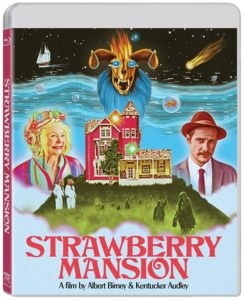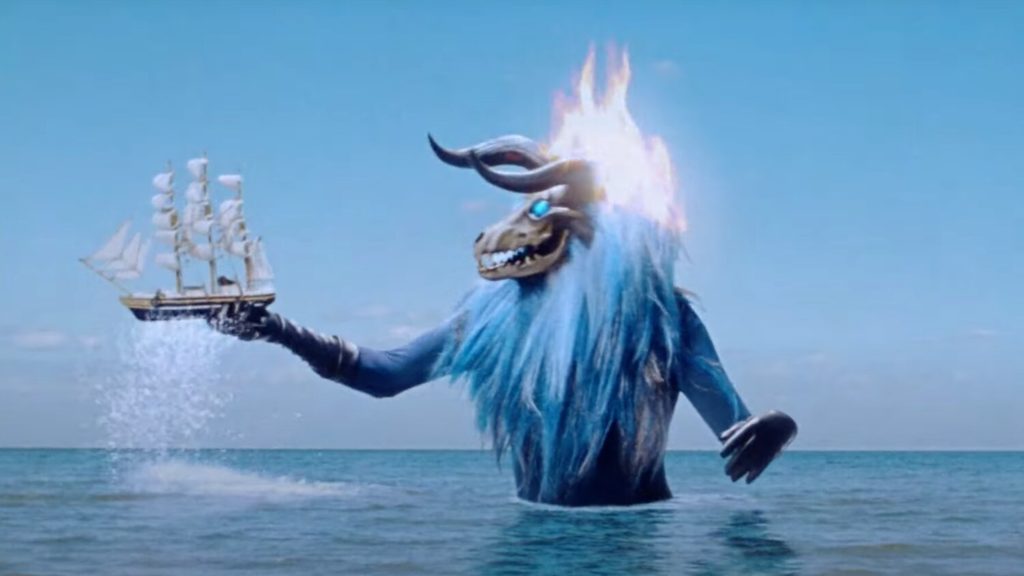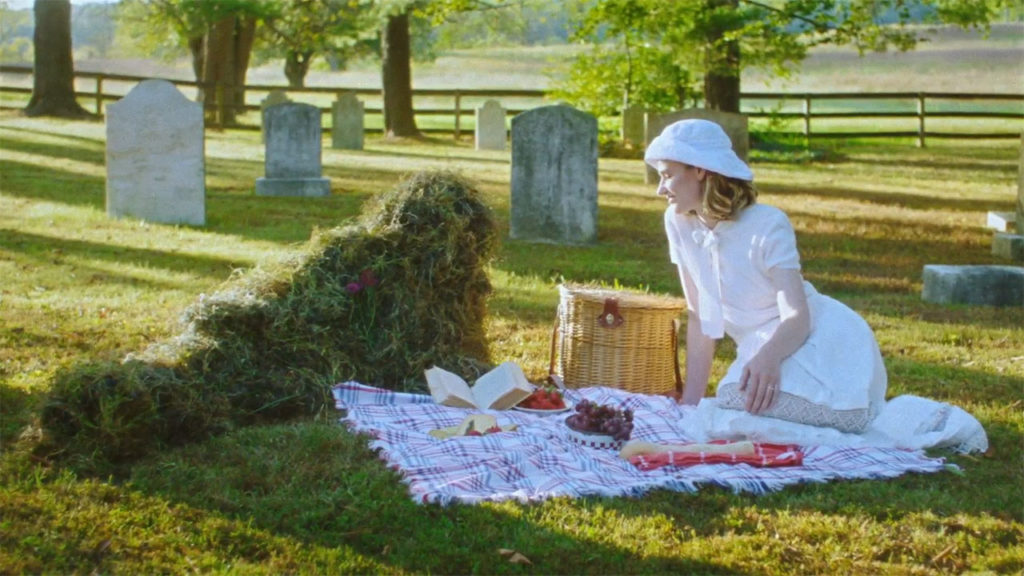Life is but a Dream?
DIRECTED BY KENTUCKER AUDLEY & ALBERT BIRNEY/2022 (U.S. Limited Theatrical Release)
BLU-RAY STREET DATE: JUNE 21, 2022/MUSIC BOX FILMS

When you’ve left your humanoid sailor rodent shipmates behind and your head has become a flaming comet careening towards the Earth, it might be time to wake up. Or is it?
It’s 2035, and the government is now taxing individual elements that appear in our dreams. It’s not much, but it can add up. That arbitrary violin player’s violin? Seventeen cents on its $1500 value. That colorful hot air balloon? Fifty-two cents on its $35,000 value. That wounded buffalo that just appeared? Twenty-five cents on its $5000 value. The dandelion that is plucked from the poor buffalo’s open wound? Three cents on its one-dollar value. A fuzzy caterpillar? To be determined…
For haggard auditor James Preble (played by the film’s co-writer and co-director Kentucker Audley), life is anything but a dream. His brown suit is just a few fraying threads away from derelict attire. He looks sweaty and tired, but unsure of why. He’s compelled to frequent the Cap’n Kelly’s Fried Chicken drive thru even though he seems repulsed by it. Hampered by the usual fast food speaker incoherence, he lets himself get talked into one of their new chicken shakes. In that moment, you can almost see Preble’s soul leave his body. This is in the first ten minutes of Strawberry Mansion, before he even arrives to the actual Strawberry Mansion.
Wall to wall-to-wall VHS tapes. Well over 2000 of them. That’s what adorns the walls of the titular isolated country home. Most of them are unlabeled and arranged in no discernible order. They are the extensive dream archive of the mansion’s sole inhabitant, a sweetly strange old lady called Arabella (Bella) Isadora (Penny Fuller, radiant and mysterious). Bella’s gotten a bit behind on her dream taxes. Years behind. So, Preble has a lot of work cut out for himself. Fortunately, he loves his work. Perhaps he loves combing through the dreams of others (with the help of his enormous overhead consciousness translator contraption) more than his own lonely life. There’s really no “perhaps” about it- he’s there for this, nowhere for anything else.

Bella’s dreams prove particularly immersive. In them, she is her idealized younger self (played by actor/director Grace Glowicki) in a full Victorian cream ivory wedding dress. How is it that her surreal pastoral inner world is so lucid, so… natural? Simple- there are no ads. Ads? Yes, ads. Secret ones, in our dreams. That’s the whole thing. Strawberry Mansion doesn’t dwell on it (in fact, it never explains exactly why and how the dream tax was initiated), but it doesn’t take an economic genius to deduce that where such potential commerce exists, taxation would surely follow. Of course, this sucks- but it’s a way of life in 2035. The truth of how Bella managed to sleep ad-free for so many years gives way to the plot of Strawberry Mansion. Let’s just say that not everyone is happy about Bella’s breakthrough… some quite close to home.
This said plot is the most traditional thing about Strawberry Mansion. With its striking primary colors, a tendency for everything in a given scene (and I do mean everything) to all be a singular ghastly color (Pepto Bismol pink is the overriding choice), and freakishly realistic animal heads (well, not that painted cardboard frog head) of various anthropomorphic dream characters, this is the kind of movie that, when playing, anyone passing by who’s not already watching it will most certainly come to a sudden stop out of pure perplexed curiosity. “…What is this??”, they will ask. Don’t try to explain it there and then. All anyone can and should say is, Strawberry Mansion. If they dismiss it as Inception by way of Wes Anderson on a d.i.y. budget, well… they’re partly right. But that’s also terribly reductive. Unlike Inception itself, this is a film that feels truly dreamlike.
In Strawberry Beginnings, the forty-one-minute making-of featurette on the Blu-ray, the film’s co-creators Albert Birney and Kentucker Audley talk about their varied backgrounds and how their mismatched skill sets complement one another, if only for this project. Birney describes himself as having come from animation and experimental filmmaking, whereas Audley is said to have a more traditional filmmaking background, i.e. “movies with people talking”. It’s a dynamic that evokes the great pairing of Marc Caro and Jean-Pierre Jeunet, the French creative duo who gave the world the darkly wonderful films Delicatessen (1991) and The City of Lost Children(1995). Though watching their level of wondrous recall (though Birney does most of the talking), one would never know that Strawberry Mansion is not at all their first film together.

Being one of the co-directors, and demonstrably talented as an actor, it’s not surprising that Audley maintains just the right tenor as the film’s lead. The part of Preble, a man who is challenged to slowly transition from burnt-out bureaucrat to emancipated romantic, welcomes any number of interpretations. Audley plays it refreshingly grounded, allowing the movie’s wondrous world itself (primarily overseen by his co-director) to fuel the imaginative center of Strawberry Mansion. (The mansion’s exterior? A modified vintage dollhouse painted strawberry color and photographed in forced perspective. Old fashioned in every way, but it works perfectly). Without the equally committed performances of those around him, however (particularly Fuller and Glowicki, who’s role grows increasingly as the story goes on), Audley would no doubt find himself out to sea.
Music Box Films has crafted a terrific Blu-ray release for Strawberry Mansion. Not only is the film itself presented vibrantly and sonically resonant (Dan Deacon’s music score is legit ethereal), but there’s a nice little bevy of extras. Besides the aforementioned Strawberry Beginnings, we get an assortment of deleted & extended scenes, a directors’ audio commentary, an interesting trial and error reel of test footage & animation, a watercolor and collage gallery, the Dan Deacon soundtrack & music video, and two quite cool experimental short films by Albert Birney, Cactus (18 minutes; 2004) and Buzzer (9 minutes; 2018). Buzzer has a short optional video introduction. The sleeve insert has reversible artwork, and inside, there’s several punch-out old-fashioned trading cards! Even the film’s poster illustration evokes childlike wonder with a promise of the strange.
Moss men, a trumpet-playing stop-motion skeleton, a roaming horde of people made of raw videotape…. Effects practical, miniatures, computer generated… All of it is brilliantly smashed down equally to 16mm film, giving Strawberry Mansion a tactile visual democracy. Without having actually experienced the film, it’s particularly impossible to peg Strawberry Mansion ahead of time. The involuntary sizing-up of the movie based purely upon the poster and/or trailer yields either a warning or a promise, that this film, with its handcrafted reality and full-on commitment to whimsical weirdness, will either be insufferable or thoroughly charming. That it turns out to very much be the latter. Though never cute or comfortable, for people who appreciate a little dream logic in their otherwise relatable narrative, Strawberry Mansion is a truly sweet delight.



